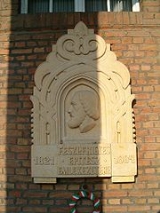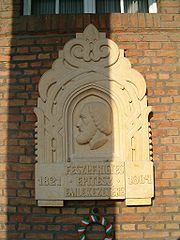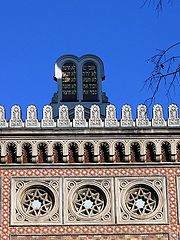
Frigyes Feszl
Encyclopedia
Frigyes Feszl was an architect
and a significant figure in the Hungarian romantic movement.


Feszl attended the Piarist gymnasium
between 1830 and 1835, subsequently studying under architect József Hild
. In 1839 he was able to travel overseas and with his brother Jozsef enrolled in the Fine Arts Academy in Munich
.
He married Regina Hoffman (d. 1851) in 1849 who bore him two children, Regina (1849–1870)and Frigyes (1850-19100. Feszl remarried after his first wife's death, in 1858 he married Vilma Quandt (1827–1902).
Between 1861 and 1865 he studied painting in Paris
and became a member of the architect's guild in 1866.
1846-49
1851-53
1854-1863
1872-74
1876-1884
(works in collaboration with others: Former Capucine Church, Water town (St Elizabeth Parish Church) and Abbey, Christine Town tunnel entrance, with Jozsef Pan: former London Hotel in the inner city.)
Architect
An architect is a person trained in the planning, design and oversight of the construction of buildings. To practice architecture means to offer or render services in connection with the design and construction of a building, or group of buildings and the space within the site surrounding the...
and a significant figure in the Hungarian romantic movement.


Life
Born into a family of German origin, Feszl's father was a master wood carver. He was the fifth of fourteen children and two of his brothers, Jozsef (1819–1866) and Janos (1822–1852) also became architects.Feszl attended the Piarist gymnasium
Gymnasium (school)
A gymnasium is a type of school providing secondary education in some parts of Europe, comparable to English grammar schools or sixth form colleges and U.S. college preparatory high schools. The word γυμνάσιον was used in Ancient Greece, meaning a locality for both physical and intellectual...
between 1830 and 1835, subsequently studying under architect József Hild
József Hild
József Hild was a Hungarian architect. One of the major exponents of neoclassical architecture of the time, he played an important part in the remodelling of Pest during the so-called reform era .- Life and career :...
. In 1839 he was able to travel overseas and with his brother Jozsef enrolled in the Fine Arts Academy in Munich
Munich
Munich The city's motto is "" . Before 2006, it was "Weltstadt mit Herz" . Its native name, , is derived from the Old High German Munichen, meaning "by the monks' place". The city's name derives from the monks of the Benedictine order who founded the city; hence the monk depicted on the city's coat...
.
He married Regina Hoffman (d. 1851) in 1849 who bore him two children, Regina (1849–1870)and Frigyes (1850-19100. Feszl remarried after his first wife's death, in 1858 he married Vilma Quandt (1827–1902).
Between 1861 and 1865 he studied painting in Paris
Paris
Paris is the capital and largest city in France, situated on the river Seine, in northern France, at the heart of the Île-de-France region...
and became a member of the architect's guild in 1866.
Major works
1845- Vigadó Concert HallVigadó Concert HallVigadó is located on the right-hand side of the Danube in Budapest, Hungary. Although the acoustics of Budapest's second largest concert hall are lacking, the building itself, designed by Frigyes Feszl in 1859 makes a bold impression along the Pest embankment...
, Pest
1846-49
- New Servite Church, Therese town, Pest
- V. Nador street no 22, Oszvald House, Pest
- V. Vaci Street 57, Balassovits House, Pest
- Mor Baths, Pest
1851-53
- Dohány Street SynagogueDohány Street SynagogueThe Great Synagogue, also known as Dohány Street Synagogue or Tabakgasse Synagogue, is located in Erzsébetváros, the 7th district of Budapest. It is the third largest synagogue in Eurasia and the fifth largest in the world...
, Pest - Luczenbacher chapel, Szob
- Budakeszi street 71, Kochmeister villa, Pest
- Heckenaszt villa, Pilismarot
- Kalvin Square Reformation Church, Budapest
- V. Sas Street, Frolich House, Pest
1854-1863
- Inner City Parish Church, Pest (destroyed)
- Vigado, Pest (built)
- Dohány Street Synagogue, Pest (built)
- Summer Theatre, Pest (destroyed)
1872-74
- Boys School and Priest home, VI. Nagymezo street 1., Budapest
- Danube and Castle Hill replanning, Buda
- Primary schools: Bp., VI. Szív u. 19-21.; Bp., VII. Wesselényi u. 52. ; Bp., VIII. Dankó u. 31. ;Bp., X. Szent László tér 34.
- Old Exhibition Hall, Pest.
1876-1884
- Deák mausoleum and statue plans
- Bp., Andrassy avenue 99, Mayer House
(works in collaboration with others: Former Capucine Church, Water town (St Elizabeth Parish Church) and Abbey, Christine Town tunnel entrance, with Jozsef Pan: former London Hotel in the inner city.)

